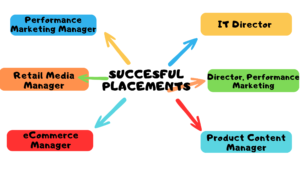For the first installment of our eP interview series, we welcome our long-time client and friend, Josh Walter. Josh is CEO of BrandJump, an eCommerce agency providing home furnishings manufacturers with a full-scale team across merchandising, content and online retail sales strategy.
Tell us about yourself and BrandJump. Give us the origin story.
BrandJump evolved from a more traditional sales agency that worked between home furnishings manufacturers and brick-and-mortar retailers. My co-founder and I realized that there was a different need for manufacturers when it came to selling online instead of in showrooms, and we built the entire BrandJump model and process around filling those needs. For example, manufacturers had a hard time understanding how to sell on Wayfair—we recruited people from Wayfair who could bring that expertise and best serve our clients. We’ve continued to find ways to meet needs like that for nearly 11 years.
Personally speaking, it was my dream to own my own business one day, and last year I was able to fulfill that by buying my co-founder’s shares in the business. So even though we’ve been in business for over a decade, in some ways this is just the beginning.
What are some of the current challenges and opportunities in your business?
I’ll start with opportunities. We’re a small (but mighty!) team, and being our size allows us to be nimble and really evolve as a company alongside the evolution of work itself. Our policies and the way we operate allow us to be open to change. Combining that with smart, talented, diverse people is a magical formula for bringing ideas to the surface that allow us to get better and better.
There is also opportunity being in a fast-changing ecommerce industry. There’s sort of a forced innovation required to stay relevant, and that means things are never boring. Every day is different.
And given the last 2+ years, the opportunity in ecommerce is expanding at a faster rate than it once was. There’s a greater willingness to invest in online, and while we primarily work with home furnishings manufacturers now, that’s not the only category. There are many different categories we could consider moving into. There’s really no ceiling to where we can go.
At the same time, that boundless opportunity presents a challenge for us to remain focused in our business. Because there are many paths we could pursue, and we have to make sure we are spending time on things that will bear the most fruit, so to speak.
A unique challenge we face with home furnishings is that these products are a considered purchase. Brick and mortar has been such a significant channel for this category because the customer wants to touch and feel something before buying it. So not only are we always thinking of ways to overcome that with the end customer, we’re also charged with showing manufacturers the opportunity that lies in online, and getting them to pay as much attention to and invest in ecommerce the way they do physical retail.
When it comes to recruiting, we look to candidates with experience in ecommerce, merchandising and buying. Coming to BrandJump often means moving from an in-house role, and helping them understand the transition to an agency role is an important, and sometimes challenging, part of our talent acquisition process.
Lastly, we also face the challenge of managing our growth, and therefore bandwidth of our team. We are a people business—we have technology and automated processes in place where it makes sense, but the service we provide is largely the expertise of the BrandJump team. We are always trying to balance growth with service and maintain a level of quality while slowly being able to add to our quantity.
Tell us about BrandJump’s transition to a 100% remote workplace. What factors drove that decision? What has been the reaction of your employees and customers?
Half of the BrandJump team had always been remote, and the other half were in-office in Los Angeles. Like many companies, we sent everyone in that office home in early March 2020. But within a few months we decided that we would stay remote indefinitely. The primary factor was that we simply could. Because half of our company was already remote, this actually felt pretty natural and doable.
Part of why we were able to do this was that we’d established a set of KPIs to measure the output from our team that was in the office. So we could move away from any mentality that productivity had to be witnessed in the office and hold the team accountable to their output in better ways.
Another factor was just wanting to take some uncertainty out of the equation for our team. There was a lot of anxiety around going back to the office and not knowing what the future held, and we didn’t want to string anyone along. We took a survey where the overwhelming majority of our team said they wanted to work remote permanently, and we did it. The reaction from the team has been extremely positive. Originally it was an appreciation for prioritizing health over everything else, but it’s grown into an appreciation for the autonomy and trust that’s been built into our team.
As far as customers, there’s been no change for them. We still travel (safely) when and where we need to, have virtual meetings where it makes sense, and the bonus to them is that we’re able to bring the best talent o their accounts because it doesn’t matter where in the U.S. someone is located.
What were some of the challenges you encountered going fully remote and some of the biggest benefits?
I think for most companies it is a challenge to help our team connect with one another in a remote environment, and to create a culture comparable to what you’d have if you were together in person all the time. We’re constantly trying to iterate ways to build that same camaraderie without physically working in the company of others.
We also were more challenged technically than I expected to be. Turns out it’s not as simple as “take your computer home!” Lessons learned. And now that we’re remote, we use video for the majority of our meetings. Not everyone was comfortable with this at first, and it took a while for us to get there.
But, there’s a benefit to that video piece as well. As I said, since some of our team was remote, I would never see them. When we started using video more comfortably, it was a new way of communicating with those team members that I rarely “saw” and actually increased our connectivity in ways I didn’t anticipate.
Another benefit is opening our talent pool. There was a time when I thought certain roles and senior leadership needed to be close enough to be in person on a regular basis. But changing my thinking has let us bring on team members who are the best fit for their role, regardless of where they’re located.
And of course, our team is simply happier, for all the reasons we’ve all read about. No commute. More productive. Work-life balance. And knowing that isn’t going to change on them.
Do you find being 100% remote helps with talent acquisition and retention?
In a word: YES.
We’ve had candidates specifically mention during the interview process that they find it to be a huge benefit to have zero requirement to be in an office. Our team comes from retail and ecommerce, and while there are hot spots for these industries, being remote doesn’t tie us to recruiting from any particular city or state.
Many people made life changes in the last two years, whether that’s moving to be closer to family or recommitting themselves to a balance between work and personal. Those things don’t need to remain up in the air because people are uncertain of where they’ll need to be for work. It takes away an X factor for their future.

Josh Walter, CEO, BrandJump












